LinkBuilder.com is the world’s largest marketplace for link building, enabling you to find and compare offers for guest posts and sponsored articles across over 300,000 websites in 150+ countries. This guide will help you quickly get started with the platform, create a project, set up filters, and find the best websites for promotion.
You can also watch our guide in video format:
Step 1: Creating Your First Project
- Registering on the Platform
- Visit LinkBuilder.com.
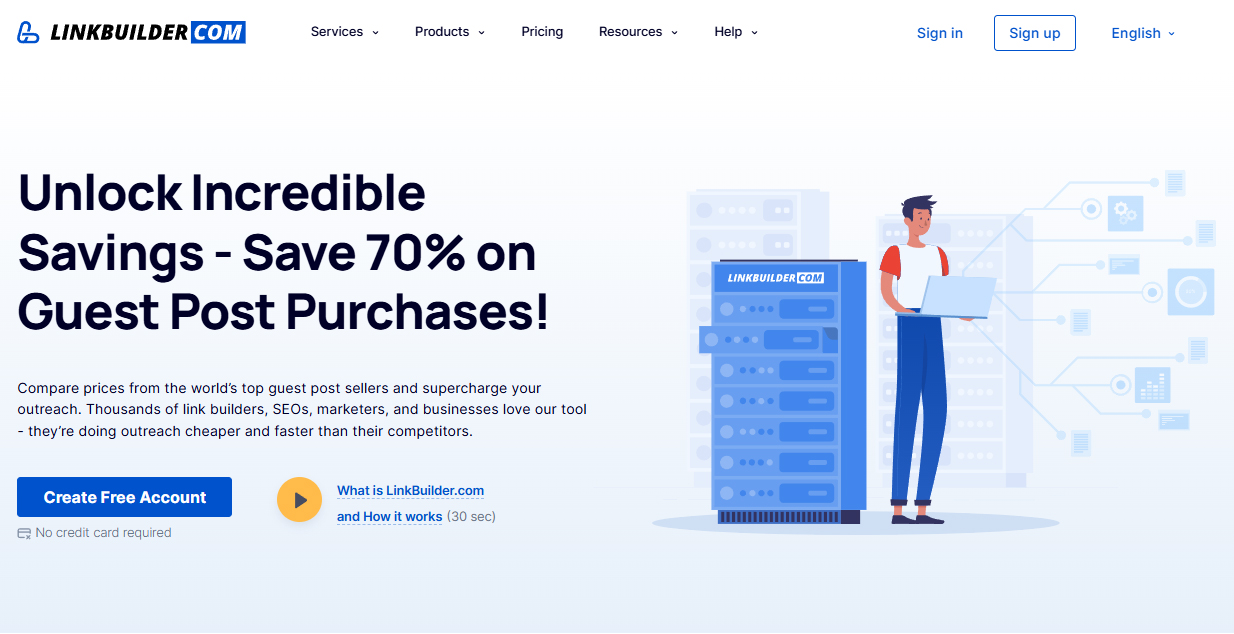
- Click the “Sign In” or “Sign up” button in the top right corner.
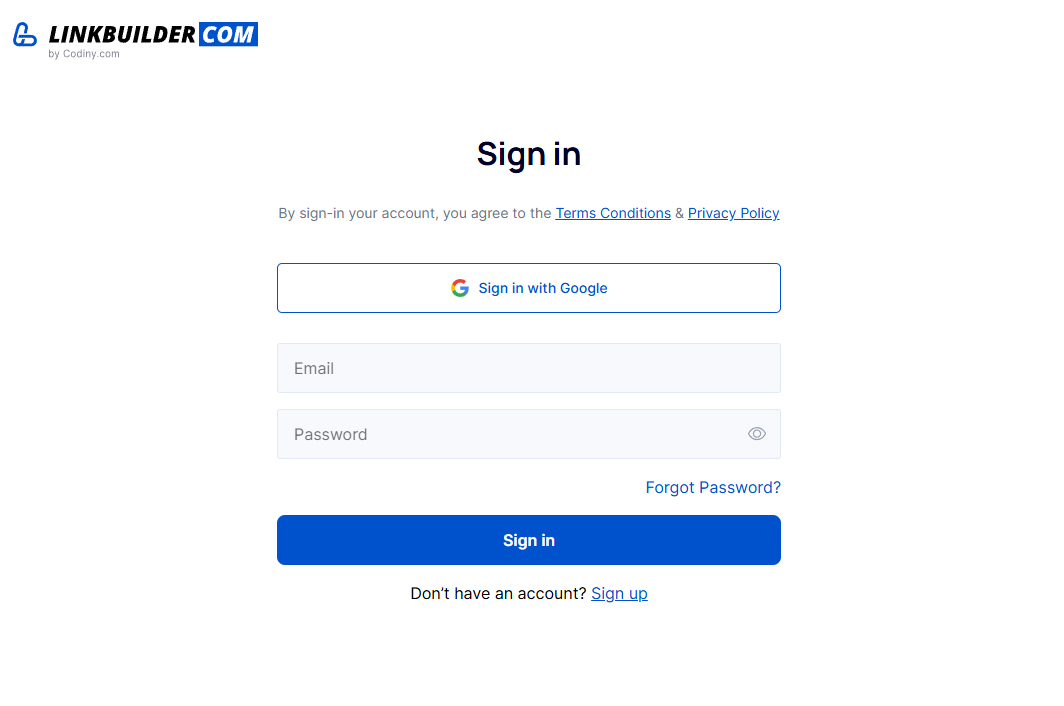
- Fill out the form: provide your email, password, and agree to the terms of use. Alternatively, sign up using your Google account.
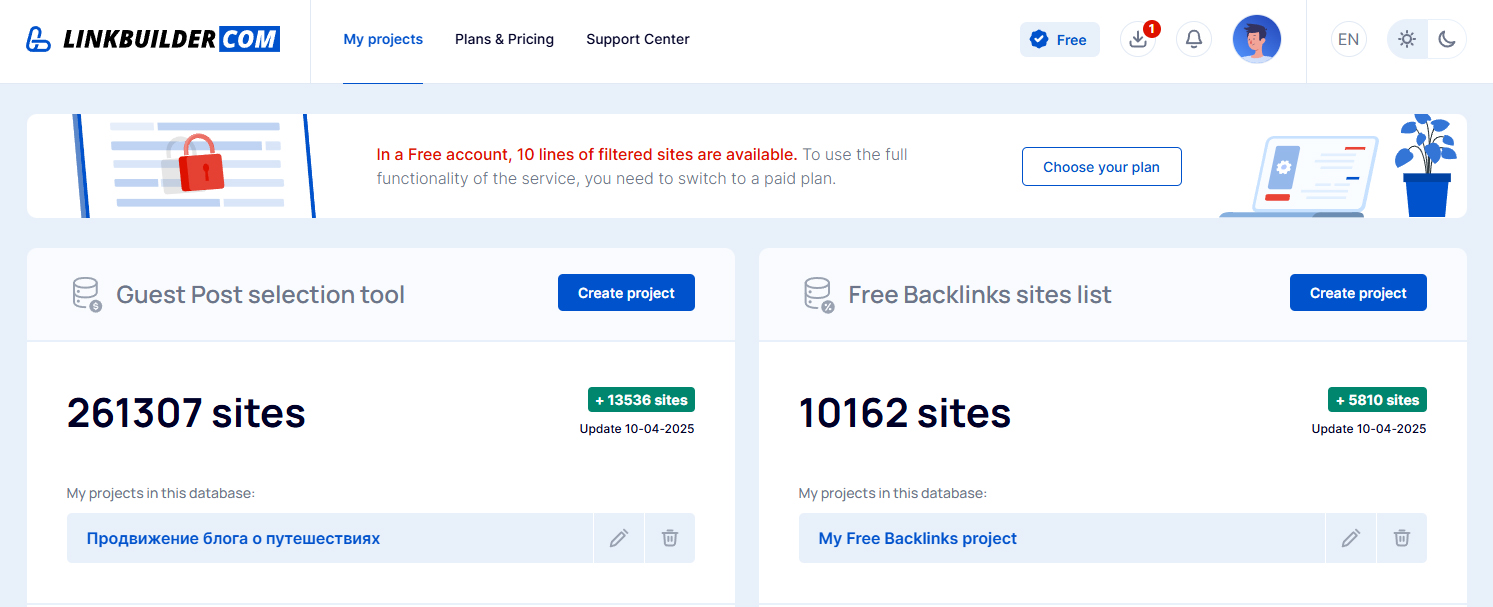
- Visit LinkBuilder.com.
- Creating a Project
- After logging in, click “Create Project” on the main dashboard.

- Enter a project name, e.g., “Promoting a Travel Blog”.

- Select a pricing plan.

- After logging in, click “Create Project” on the main dashboard.
Step 2: Using and Saving Filters
LinkBuilder.com offers powerful filters to find donor websites that align with your SEO goals. Filters save time and budget by selecting only high-quality platforms.
- Accessing Filters
- In the “My projects in this database” section, click on your project’s name.

- This opens a panel with a website catalog, filters, and sorting options.

- In the “My projects in this database” section, click on your project’s name.
- Creating and Customizing Filters
- Click “Create Filter.”
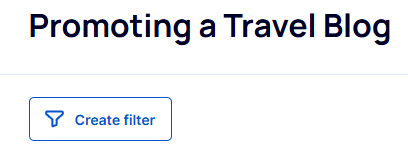
- A filter window will appear:
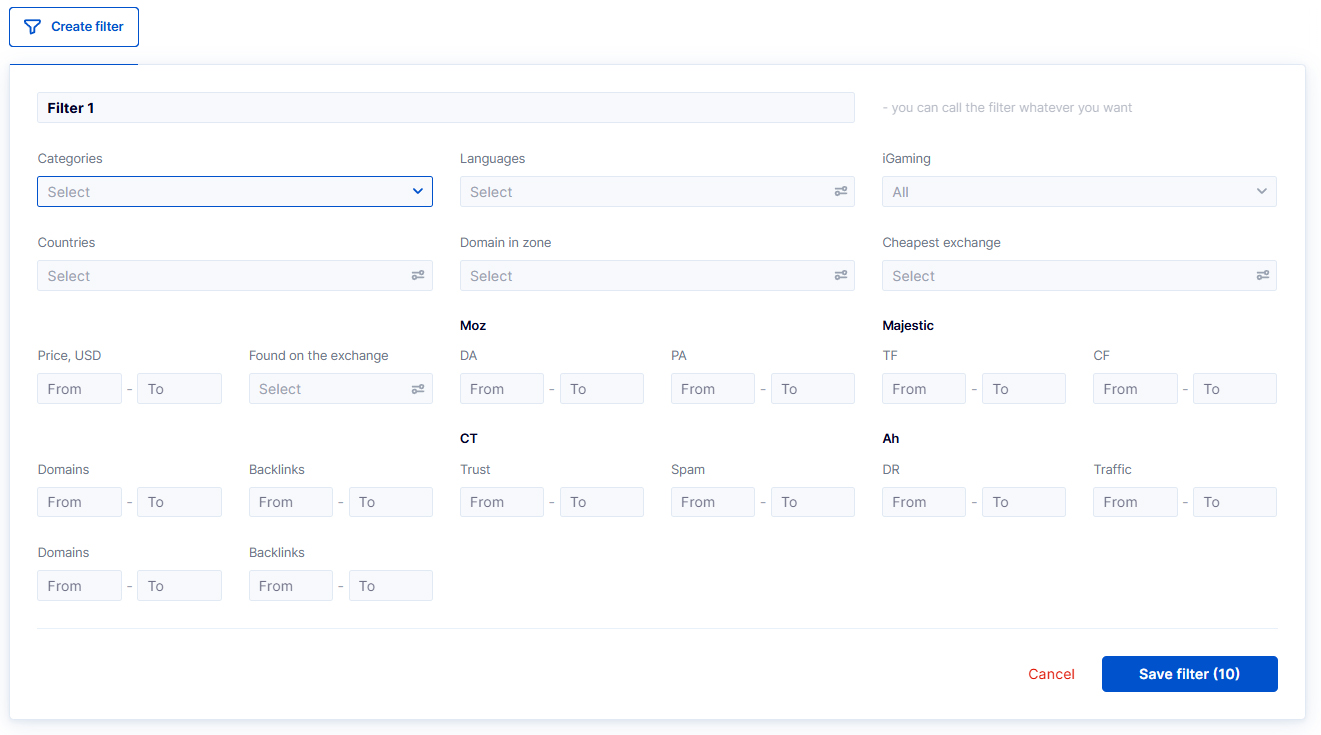
- Target Niche: Select your website’s niche (e.g., travel, technology, finance).
- Language: Specify the primary language for link building.
- Domain Zone: Choose which domain zones to include or exclude.
- iGaming: Indicate whether to include or exclude the online gambling industry.
- Cheapest Exchange: Select the most cost-effective exchange.
- Country: Choose target countries (e.g., USA, Germany) for local SEO.
- Price: Set a price range for article placements (e.g., $50–$500) to stay within budget.
- SEO Metrics:
- Moz Metrics: DA, PA
DA (Domain Authority) – A Moz metric that evaluates a domain’s overall authority based on its link profile, link quality, and other factors. Scored from 0 to 100. Higher DA suggests better ranking potential in search engines. Used for domain comparison but not a direct Google ranking factor.
PA (Page Authority) – Similar to DA but for a specific page. Considers links pointing to the page, their quality, and other factors. Scored from 0 to 100. PA helps assess a page’s ranking potential for specific queries.
- Majestic Metrics: TF, CF, Domains, Backlinks
TF (Trust Flow) – A Majestic metric reflecting a site’s trustworthiness based on the quality of linking domains. Scored from 0 to 100. High TF indicates links from authoritative, relevant sources, crucial for evaluating a “clean” link profile.
CF (Citation Flow) – Measures the volume of links pointing to a site, focusing on quantity rather than quality. Scored from 0 to 100. High CF with low TF may signal a spammy link profile. The TF/CF ratio helps assess the balance of link quality and quantity.
Domains (Referring Domains) – The number of unique domains linking to a site. More unique, high-quality, and relevant domains strengthen a link profile.
Backlinks – The total number of external links pointing to a site. High backlink counts don’t always indicate quality if the links are low-value.
- Ahrefs Metrics: DR, Traffic, Domains, Backlinks
DR (Domain Rating) – An Ahrefs metric showing a domain’s link profile strength based on the quantity and quality of external links. Scored from 0 to 100. DR accounts for the weight of linking domains’ authority. Higher DR correlates with better ranking potential.
Traffic (Organic Traffic) – An estimate of visitors from organic search (mainly Google), based on a site’s keyword rankings and search volume. Useful for gauging a site’s real popularity.
Domains (Referring Domains) – The number of unique domains linking to a site. High-quality, relevant domains boost authority. Ahrefs factors in their DR for precision.
Backlinks – The total number of external links to a site. Ahrefs categorizes them by type (dofollow, nofollow) and quality for detailed analysis.
- CheckTrust Metrics: Trust, Spam
Trust – A CheckTrust metric evaluating a site’s link profile quality, considering relevance, naturalness, and authority. Scored from 0 to 100. High Trust indicates a “healthy” profile trusted by search engines.
Spam – Measures the spammy nature of a link profile. High values (typically above 10–15%) suggest many low-quality or unnatural links, which may harm rankings. Low Spam indicates a clean profile.
- Moz Metrics: DA, PA
- Additional Parameters:
- Click “Create Filter.”
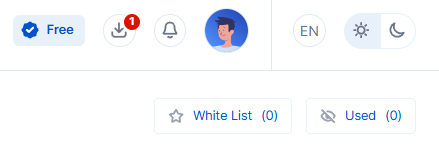
-
-
-
- Whitelist: Search only selected websites.
- Blacklist: Exclude specified websites from search results.
-
- Saving Filters
- To avoid resetting filters, click “Save Filter” and name it, e.g., “Filter for US Travel Blogs.”

- Saved filters can be quickly applied later.

- To avoid resetting filters, click “Save Filter” and name it, e.g., “Filter for US Travel Blogs.”
-
Step 3: Finding the Best Websites for Sponsored Articles and Guest Posts
- Analyzing Suggested Websites
- After applying filters, review the website catalog. Each site displays:
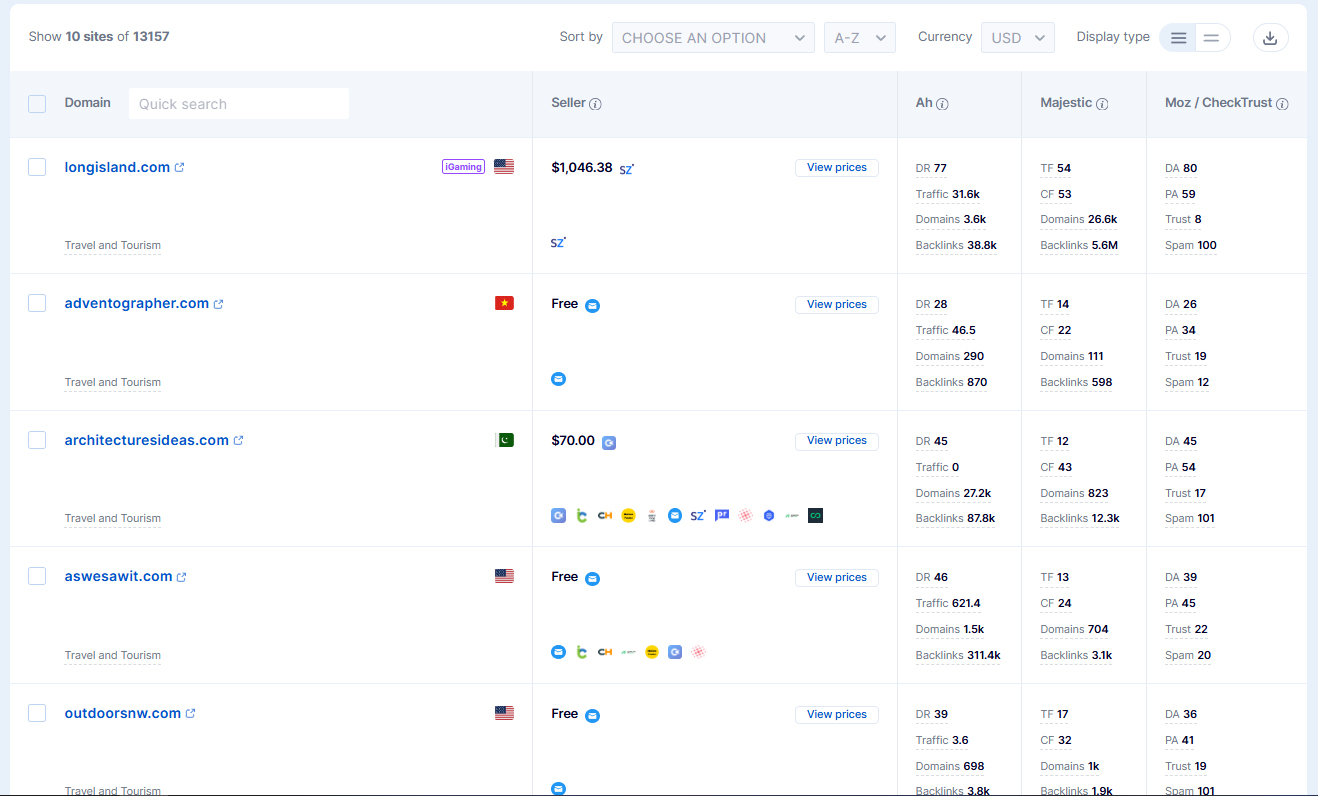
- List of sellers.
- Domain and niche.
- Placement prices.
- Country.
- SEO metrics.
- Sort the list by desired parameters, such as price or SEO metrics, by clicking the column header.
- After applying filters, review the website catalog. Each site displays:
- Selecting Platforms
- Add preferred sites to the “Whitelist” for easier comparison.
- Manually review donor sites:
- Visit the URL to assess content quality, design, and audience engagement.
- Ensure the site’s niche aligns with your project.
- Compare prices from different sellers. LinkBuilder.com aggregates data from 50+ exchanges, enabling savings of up to 70%.
- Purchasing Placements
- Select a site and click “Buy” or “Add Card.”
- Specify placement details:
- Content Type: Order article writing from the seller or provide your own.
- Anchors andURLs: Specify link text and target page on your site.
- Additional Requirements: E.g., minimum article length or inclusion of infographics.
- Confirm the order and pay through the platform (supports popular payment systems).
- Track order status in the “Orders” section. You’ll receive a link to the published article upon completion.
Additional Tips for Successful Link Building
- Regular Filter Updates: Revisit saved filters periodically, as the website database updates daily.
- Natural Link Growth: Build links gradually to avoid search engine penalties. For new sites, aim for 5–10 links per month.
- Content Quality: If ordering articles, provide a clear brief with keywords and style requirements.
- Result Monitoring: Use Google Analytics and Ahrefs to track traffic and ranking improvements post-placement.
Conclusion
LinkBuilder.com streamlines link building with its user-friendly interface, extensive website database, and advanced filters. By following this guide, you can quickly create a project, set up filters, and find high-quality platforms for guest posts and sponsored articles. Start with small budgets, test different niches, and scale your campaign as results grow.



